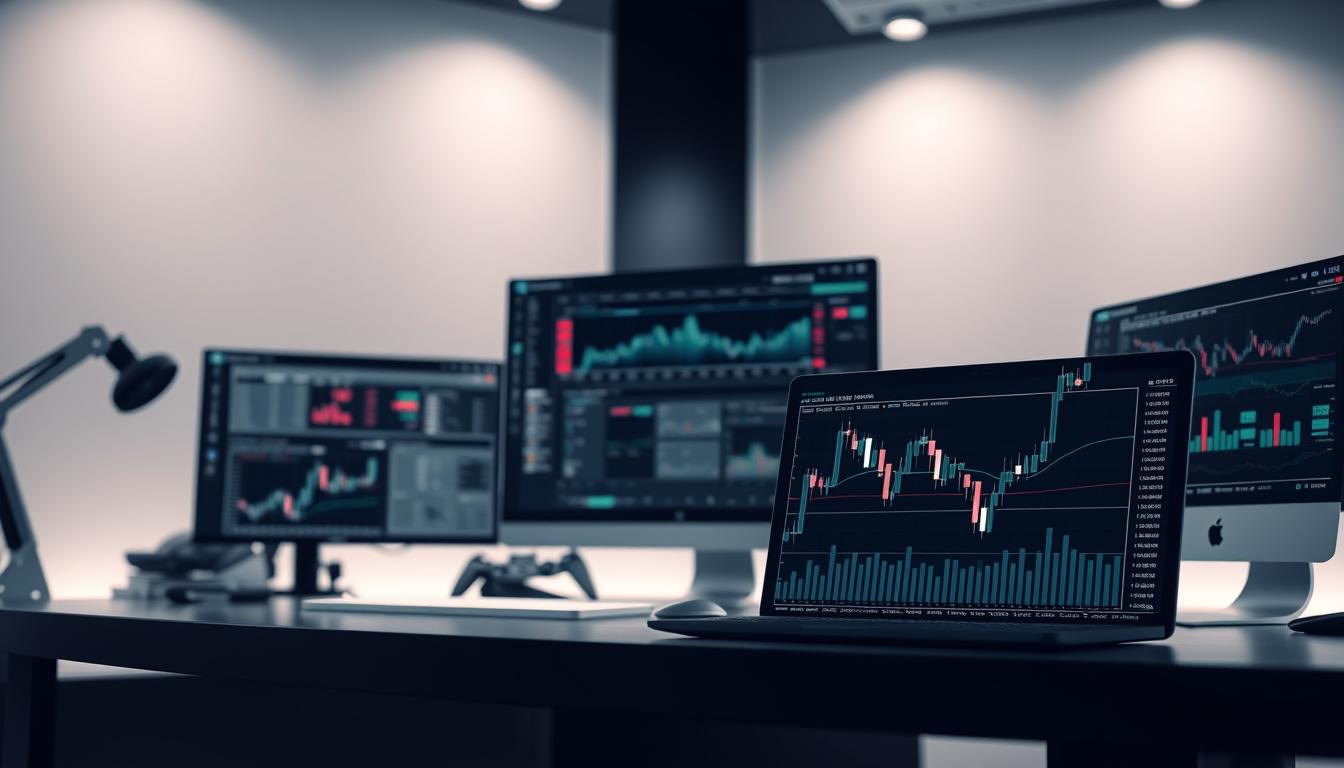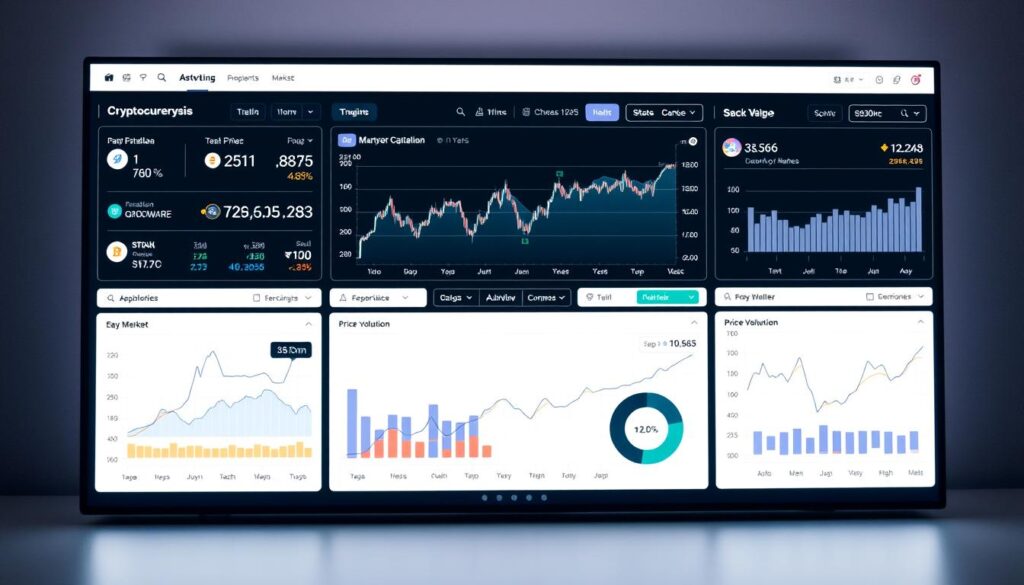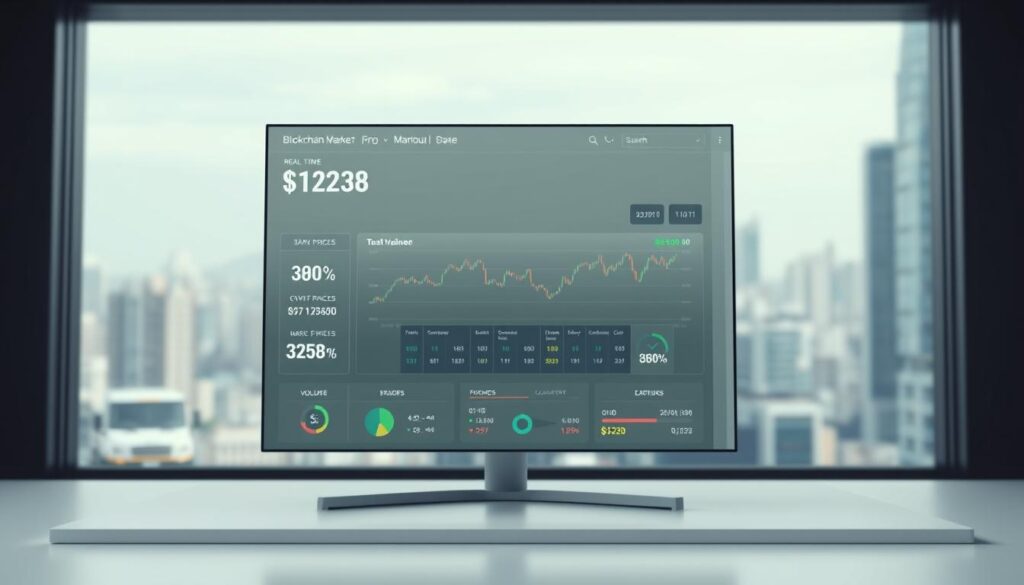Now Reading: Crypto Market Analysis: Strategies for Savvy Investors
- 01
Crypto Market Analysis: Strategies for Savvy Investors
Crypto Market Analysis: Strategies for Savvy Investors

Crypto market analysis is key for navigating the fast-changing world of digital assets. Unlike traditional markets, cryptocurrency trends are shaped by unique factors. These include blockchain adoption, regulatory shifts, and global economic shifts. Investors need sharp market insights to predict shifts and reduce risks in this volatile space.
This article outlines strategies to decode crypto markets. It explores why traditional analysis fails here and introduces tools like on-chain data and sentiment tracking. Readers will learn how to combine technical, fundamental, and behavioral insights to make informed decisions.
Key Takeaways
- Market insights help spot opportunities in crypto volatility.
- Combining analysis methods improves investment accuracy.
- Traditional tools often miss crypto’s unique dynamics.
- Tracking cryptocurrency trends requires real-time data.
- Frameworks must adapt to regulatory and technical changes.
Understanding the Dynamics of Crypto Market Analysis
Crypto market analysis needs a special approach because of its high volatility. Good strategies use technical tools and real-time data. They help find important market insights for making decisions.
Key Components of Effective Cryptocurrency Analysis
Good cryptocurrency data analysis has four main parts: on-chain metrics, social sentiment trends, technical indicators, and project fundamentals. Traders watch transaction volumes and whale activity to see changes in supply and demand. The Fear and Greed Index shows investor feelings, and technical signals like RSI or moving averages spot trend changes. Learn core technical strategies to understand price patterns well.
Why Traditional Market Analysis Falls Short in Crypto
- 24/7 global trading erases traditional market hours, amplifying volatility.
- Retail investors drive price swings more than institutional buyers.
- Regulatory shifts can destabilize prices overnight, unlike slower-moving equity markets.
The Role of Market Cycles in Cryptocurrency
Bitcoin’s halving events and altcoin dominance cycles create predictable patterns. Bull markets often start with Bitcoin leading, then altcoins gain during “altseason.” These cycles offer market insights for strategic entry and exit points.
Essential Tools for Conducting Thorough Crypto Research
Effective crypto price analysis needs the right market analysis tools and digital asset research platforms. Both beginners and experts need data-driven insights for smart decisions. Here’s how to use top resources:
- Market Data Portals: Sites like CoinMarketCap and CoinGecko rank projects by volume and market cap. Messari gives deep reports on tokenomics and team backgrounds.
- Technical Analysis Platforms: TradingView and Coinalyze offer charts for crypto price analysis. Use these to spot trends like support/resistance levels or RSI indicators. Learn more about technical setups at market trend analysis.
- On-Chain Analytics: Glassnode and CryptoQuant track blockchain metrics like transaction volume and holder distribution. Nansen adds insights into whale activity and protocol usage.
- Sentiment Tools: The TIE and Santiment quantify social media buzz, while LunarCrush monitors Reddit and Twitter sentiment scores.
- Regulatory Watch: Follow CoinDesk or Cointelegraph for updates on SEC rulings or global policy shifts affecting digital assets.
Use these tools with digital asset research to avoid blind spots. For example, combine on-chain data with news sentiment to gauge hype cycles. Regular updates from these platforms ensure no signal gets missed in volatile markets.
Fundamental Analysis in the Cryptocurrency Space

Fundamental analysis for digital assets is more than just looking at price charts. It involves examining a project’s core structure, the team’s credibility, and its real-world use. To start crypto market analysis, you need to check if the token has real value or is just for speculation.
When evaluating a project’s utility, ask important questions. How does blockchain improve its function? Is the token crucial to the system? For example, Ethereum’s smart contracts or Bitcoin’s limited supply show clear uses. Cryptocurrency data analysis tools like CoinGecko or DappRadar show how active a project is.
- Token utility: Check if the token solves a problem or creates inefficiency
- Team verification: Look at public records, past projects, and GitHub contributions
- Roadmap timelines: Compare announced goals with actual progress
On-chain metrics give unbiased views. Daily active addresses and gas fees show real use. Token distribution patterns, like locked balances and team allocations, show if everyone is working together. Digital asset research should mix qualitative aspects like whitepaper vision with data from Etherscan.
It’s key to understand how supply works. Coins with deflationary mechanisms, like Bitcoin’s halving, are different from inflationary tokens. Vesting periods for teams prevent quick sell-offs, and token burn mechanisms reduce supply. These factors help ensure long-term success.
Technical Analysis Techniques for Digital Assets
Learning technical analysis helps you understand crypto prices better. Traders use charts, indicators, and patterns to guess price changes. Start with daily charts for trends and hourly for quick trades to see both long and short-term views.
Chart patterns show hidden clues. Bullish flags or descending triangles hint at price changes. Crypto-specific buying phases before big price jumps are also key.
Support and resistance levels are important. They often match round numbers or past highs, acting as mental barriers.
Popular indicators for crypto include:
- RSI (14-period): Adjusted for crypto’s big swings, shows when prices are too high or too low
- MACD (12,26,9): Shows when momentum changes
- Bollinger Bands (20-period): Captures big price moves
Tools like on-chain volume profiles show where the market is. Use TradingView or its crypto dashboards to see these metrics live. Mix technical signs with market data to avoid false signals.
Make a system that works for you. For example, a bullish RSI divergence at support with rising volume might mean a price change. Always check patterns with different tools. No single sign can promise success in crypto’s fast-changing markets.
Sentiment Analysis: Gauging Market Psychology
Sentiment analysis uncovers hidden investor behavior clues. Social media sites like Twitter and Reddit provide real-time sentiment insights. Use tools like Twitta or Sentimentr to track hashtags, mentions, and sentiment scores.
Rising social buzz often signals price shifts in blockchain market updates.
- Monitor Reddit posts and comments for bullish/bearish keywords
- Use Telegram bots to scan crypto group activity
- Track Google Trends for search volume spikes
Fear and Greed Index Interpretation
The Crypto Fear & Greed Index combines six data points: volatility, trading volume, and social media trends. High greed readings (above 70) often signal sell times, as seen in 2021’s Bitcoin rally. Low fear levels (below 20) often precede price increases.
Market insights from this tool help spot overextended markets.
Community Engagement Metrics
GitHub commit activity and Discord user growth offer real market insights. Active developer contributions show project momentum. Stagnant participation may signal weakening fundamentals.
DAO voting and token holder surveys also show community strength. Tools like DappRadar track these blockchain-based engagement signals.
By combining these signals with cryptocurrency trends, you get a full view of market psychology. Don’t rely on just one metric—mix sentiment data with on-chain analytics for better decision-making.
Crypto Market Analysis Through Blockchain Data
Blockchain technology gives us a clear view of market movements through real-time data. Analysts use blockchain market updates to find trends in transaction patterns and network activity. This data-driven method helps investors make smart choices based on verified metrics.

Transaction volume shows more than just price charts. Looking at adjusted transaction values, without big whale transfers, shows real user growth. Metrics like new wallet addresses and active daily users show how the network is growing. This often signals future price trends.
Tracking whale activity reveals big moves by institutions. Tools like Etherscan or Santiment track large wallets, showing when whales buy or sell. Stablecoin transfers to exchanges can also signal market changes. For example, when Bitcoin moves from personal wallets to exchanges, it often leads to short-term dips.
For miners, hash rate metrics show network health. A rising hash rate on Bitcoin’s blockchain means confidence, while sudden drops may mean trouble. Staking data in proof-of-stake networks, like Solana’s validator participation rates, shows community engagement. These insights are key for cryptocurrency data analysis and digital asset research.
By combining these metrics, we get a complete picture. Investors using blockchain data can spot trends before they affect prices. This turns raw data into useful insights for staying ahead.
Navigating Bitcoin Market Trends
Bitcoin’s dominance is key in global crypto market analysis. Traders use Bitcoin market trends and unique on-chain data to forecast cycles. Metrics like the Stock-to-Flow (S2F) model and Realized Cap HODL Waves show holder sentiment and price trends.
Analysts also look at the MVRV Z-Score for profit/loss ratios. They check RHODL (Holder Days) ratios to see long-term holding trends.
- Halving cycles: Bitcoin’s block reward halvings every four years reduce issuance, historically triggering price surges. The 2024 halving may follow this pattern.
- Macro correlations: Bitcoin often mirrors tech stocks during risk-on environments and gold during inflationary periods, impacting crypto market analysis.
- Lightning Network growth: Transaction data on Layer 2 networks like Lightning signals real-world adoption beyond speculation.
Bitcoin’s dominance index shows its share of total crypto market cap. When rising, it signals risk-off sentiment; falling dominance suggests altcoin outperformance. Investors monitor these shifts to time entries during Bitcoin bull phases or alt season. Tools like Glassnode and IntoTheBlock provide real-time crypto market analysis for these trends.
Altcoin Analysis: Finding Potential Gems
While Bitcoin gets all the attention, altcoins hold hidden gems for those who look closely. To find real value, you need a solid crypto price analysis method. This guide will help you understand three key factors that shape cryptocurrency trends in altcoin markets.
Correlation Analysis with Bitcoin
- Track beta coefficients to measure altcoin volatility relative to Bitcoin
- Use historical data to spot decoupling events during “altseasons”
- Watch for inverse correlations signaling independent value drivers
In 2021, DeFi tokens like UNI outperformed Bitcoin by 300% at key points. This shows how seasonal trends can help predict market movements.
Identifying Unique Value Propositions
- Assess technical innovation over marketing buzz
- Map projects against solved problems in their niche
- Analyze developer activity via platforms like Etherscan
Solana is a great example. It solved Ethereum’s congestion problem, leading to a 14,000% price increase in 2021. True value comes from solving real-world problems, not just hype.
Liquidity and Volume Considerations
When looking at smaller-cap coins, you need to be extra careful:
- Slippage tests on top exchanges (Binance, Coinbase)
- Order book depth analysis using tools like CoinMarketCap
- Spot artificial volume via CoinMetrics data
In 2022, 60% of top-100 altcoins had fake trading volumes, Glassnode found. Always check if trading is spread across different platforms.
Regulatory Impact on Cryptocurrency Markets
Regulations play a big role in the world of cryptocurrencies. They lead to blockchain market updates and change cryptocurrency trends. Agencies like the SEC, CFTC, and Treasury Department make rules that can cause big price swings.
For example, when the SEC approves Bitcoin ETFs or cracks down on unregistered tokens, prices can jump or drop sharply. Investors need to keep an eye on these changes to make sure their strategies are up to date.
Markets quickly react to new rules. In 2021, when the SEC said no to a Bitcoin ETF, prices fell for a bit. But, when DeFi got new licensing rules, some altcoins went up. This shows how policy changes can affect how assets perform.
Important things that can cause market moves include enforcement actions, court decisions, and global agreements like the G20’s crypto tax plans.
- Track SEC hearings and proposed rules via gov.info.usa.gov
- Monitor CFTC enforcement actions on their official site
- Follow Treasury sanctions lists impacting crypto firms
Smart investors look at regulatory calendars to guess when big decisions will come. By moving to compliant projects before big SEC actions, they can reduce risk. It’s important to mix regulatory analysis with technical and fundamental research for a full view of market insights.
Stay updated through official sources to handle this fast-changing world well.
Risk Management Strategies for Crypto Investors
Risk management is key for safe crypto investing. It’s about finding the right balance between risk and safety. Let’s look at some effective ways to protect your investments from market ups and downs.
Position Sizing and Portfolio Allocation
Start with position sizing. Don’t put more than 1-5% of your money into one trade. Adjust this based on how new the project is. Spread your money across different types of assets.
Put 60% in stable assets like Bitcoin, 30% in altcoins, and 10% in new, risky tokens. Check and adjust your portfolio every quarter. Use tools like CoinMarketCap or Chainalysis for this.
Stop-Loss Execution
- Set stops 10-20% below your entry price for stablecoins, and 30-50% for riskier tokens.
- Use technical levels, like the 50-day moving average, to catch sudden drops.
- Exit trades after 30 days if they’re not showing a clear trend.
For sudden price drops, use trailing stops to lock in profits while still allowing for price increases.
Hedging and Diversification
Use futures contracts or inverse ETFs to protect against losses. Mix speculative bets with stable investments in DeFi or mining stocks. Spread your investments across different areas, like payments, NFTs, and DeFi.
Keep an eye on market trends and how different assets move together. Use tools like Santiment for this.
Macro-Economic Factors Affecting Digital Asset Valuations
Global economic changes affect crypto prices. Traders need to mix market insights with blockchain data. Things like interest rates, inflation, and currency crises influence prices.
- Central bank policies: Fed rate hikes or quantitative easing
- Inflation metrics: Year-over-year CPI reports
- Regional currency instability: Argentina’s peso collapse or Turkey’s lira crisis
- Equity market correlations: NASDAQ drops often mirror crypto selloffs
Inflation can make people turn to Bitcoin as a safe place for their money. In 2020, Venezuela’s hyperinflation led to a big increase in crypto use, even with government bans. This shows how people in tough economies turn to crypto.
What happens in the stock market and with commodities can also affect crypto. For example, when gold prices fell in 2020, Bitcoin’s value went up. This shows a competition for being a safe investment. Also, the cost of mining Bitcoin is tied to energy prices like oil, which can change how much it costs to run the network.
Effective crypto market analysis means keeping an eye on:
- Fed meeting minutes and forward guidance
- Monthly inflation reports from the BLS
- Real-time forex movements for emerging markets
Tools like the Fear & Greed Index or CBOE volatility metrics help understand these effects. Services like Coin Metrics or Glassnode show how blockchain data relates to economic events. This gives valuable market insights.
Investors should look at all these factors together. For example, in 2022, rising interest rates led to a drop in both crypto and stocks. But in 2023, when interest rates went down, things started to move in different ways. Keeping up with these changes through blockchain market updates helps investors stay ahead.
Developing Your Personal Crypto Analysis Framework
To build a personal crypto analysis system, mix different methods. Start with crypto market analysis like technical charts, on-chain data, and sentiment trends. Use tools like TradingView or Santiment to combine these easily. Choose signals that match your investment goals, whether short-term or long-term.

Then, create your own market analysis tools to improve decisions. Use platforms like TradingView’s Pine Script or Python libraries for custom alerts. For example, set alerts when Bitcoin’s network hash rate goes up and volatility falls. These alerts help filter out unnecessary information.
- Combine on-chain data (e.g., NVT ratio) with price trends
- Automate alerts using platforms like Coinalyzer or Pythia
Keep track of your performance by writing down every decision. Note when you enter or exit, what analysis you used, and the results. Use tools like Notion or Google Sheets for this. Review your work monthly to see what digital asset research methods work best. Drop strategies that don’t perform well and refine your approach.
Adjust your framework as the market changes. In bull markets, look at momentum; in bears, focus on fundamentals like adoption. Keep updating your system to stay current with the crypto world.
Common Pitfalls in Cryptocurrency Analysis to Avoid
Successful crypto price analysis needs careful watching for biases and wrong assumptions. Many investors get caught in traps that mess up their market views. This leads to big mistakes.
- Recency Bias: Giving too much weight to recent price changes as a guide for the future. Example: Thinking a short-term rise means long-term success.
- Echo Chambers: Relying too much on social media groups that only agree with you. Look for different views to question your own.
- Overfitting Models: Creating plans that perfectly fit past price moves but don’t work in real trading. Test them with new data.
- Influencer Blind Spots: Following expert advice without checking it yourself. Make sure to verify claims with actual data.
- Ignoring Tokenomics: Getting caught up in the excitement without looking at the coin’s real use. Check the burn rate, supply, and how it’s used in the world.
Combine technical charts with deep research to avoid missing the big picture. Use tools like Santiment or CoinMetrics to check sentiment and network data. Always be wary of stories that don’t have solid facts. Good crypto analysis mixes feeling with facts.
Future-Proofing Your Crypto Investment Strategy
Keeping up with crypto trends means always watching for new blockchain updates and tech. Investors should keep an eye on DeFi platforms and NFTs, which are growing in gaming and real estate. Solutions like Bitcoin’s Lightning Network are making transactions faster and cheaper.
Central bank digital currencies (CBDCs) are also changing the game. Projects like China’s digital yuan could change how we pay worldwide.
Institutional investors are making a big impact, with companies like Fidelity and MicroStrategy leading the way. It’s important to balance quick wins with long-term investments. Look for projects with big plans and real-world uses.
Tracking things like Ethereum’s move to proof-of-stake or Polkadot’s work on connecting different blockchains is key. Stay updated with CoinDesk or blockchain explorers. Newsletters from Chainalysis or ConsenSys can keep you in the loop on adoption and security.
Forums like r/CryptoCurrency on Reddit can show you what the community thinks. This can influence prices.
A solid strategy mixes diversification with avoiding hype. Use tools like Glassnode for Bitcoin trends or Dune Analytics for DeFi data. Keep learning with Blockchain Commons courses to stay current.
Successful investors stay flexible, using both fundamental analysis and macro awareness. This way, strategies grow with the blockchain market, moving into big business and global finance.
FAQ
What is crypto market analysis?
Crypto market analysis looks at many things in the cryptocurrency world. This includes price trends, how much is being traded, and on-chain metrics. It helps make smart investment choices and spot new chances.
Why do traditional investment strategies often fail in crypto?
Old investment plans don’t work well in crypto because of its unique ups and downs. There are also rules that change fast and new tech that surprises everyone. This leads to wrong guesses and bad results.
What are the key components of effective cryptocurrency analysis?
Good crypto analysis looks at on-chain metrics, what people are saying online, technical signs, and how solid a project is. This gives a full picture of the market and how assets are doing.
How can I track Bitcoin market trends?
To follow Bitcoin trends, use tools like the Stock-to-Flow model and MVRV Z-Score. Also, keep an eye on the Bitcoin halving cycle. These help guess price changes and market shifts.
What tools are recommended for cryptocurrency data analysis?
For crypto data analysis, use sites like CoinMarketCap and CoinGecko for prices. Glassnode or CryptoQuant offer on-chain data. And TradingView is great for technical analysis.
How does sentiment analysis affect cryptocurrency investments?
Sentiment analysis shows what people think by looking at social media and the Fear and Greed Index. It helps predict price changes based on how people feel.
What is the significance of regulatory impact on cryptocurrency markets?
Rules can really change how people feel about crypto, affecting prices and plans. Good rules can help growth, while bad ones can slow it down.
What are common pitfalls in cryptocurrency analysis to avoid?
Avoid mistakes like focusing too much on recent events and ignoring other important info. Don’t follow influencers without checking their track record. Also, be careful with on-chain metrics and tokenomics to make smart choices.
How can I develop my personal crypto analysis framework?
To make your own crypto analysis plan, mix different methods like looking at the basics, tech signs, and what people think. Create your own indicators and alerts. Keep track of your progress and notes.
What macro-economic factors should I consider when investing in cryptocurrencies?
When investing in crypto, think about money policies, inflation, how currencies are doing globally, and stock market trends. These all affect how valuable and popular digital assets are.















